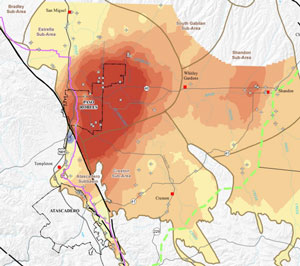County supervisors let water ordinance expire
No regulations are put into place to restrict new development
 The Paso Robles Groundwater Basin emergency ordinance, which was approved in 2013, will expire in August. The San Luis Obispo County Board of Supervisors chose to not adopt a new ordinance proposed by county staff on Tuesday. The proposed ordinance included banning new agricultural plantings in areas with dwindling groundwater basins unless it would be offset with water conservation.
The Paso Robles Groundwater Basin emergency ordinance, which was approved in 2013, will expire in August. The San Luis Obispo County Board of Supervisors chose to not adopt a new ordinance proposed by county staff on Tuesday. The proposed ordinance included banning new agricultural plantings in areas with dwindling groundwater basins unless it would be offset with water conservation.
“No matter what happens, the state is going to require us to manage these basins,” First District Supervisor Chair Frank Mecham said. “It doesn’t make a difference if we implement whatever we implement. … I know the concern is that the emergency ordinance expires and the rushes to plant and everybody is going to go out and do what they’re going to do.”
The motion, to go with the option to let the ordinance expire and to not put any regulations in place, made by Fifth District Supervisor Debbie Arnold, was approved 3-2 with Second District Supervisor Bruce Gibson and Third District Adam Hill dissenting. Arnold also asked that county staff bring back a map showing all the private land within the basins in question to show the county how much of the land could yet be developed. She said she doesn’t want anyone to think she doesn’t recognize that the county could be inundated with more pumping.
“Are we going to assert our local control, put in a reasonable program to ensure water neutrality in every basin that’s in [the problem basins identified by the state]?” Gibson said. “Because if we don’t and sort of wait for the process to evolve we have two more years before anything happens. We’re going to have a bigger problem in two years.”
“As part of the ag community, I say please be cautious if you’re looking at any of these things,” Fourth District Supervisor Lynn Compton added.” They have a lot of unintended consequences on that community.”
The plan’s major steps would have included:
- Determine water amount currently used
- Determine acreage and water use of new crops
- Proximity analysis required on a case by case basis
- Evaluate drawdown impacts on neighboring irrigation and domestic wells to demonstrate that new groundwater pumping will not have the effect of lowering well levels in the area of the new pumping
- Issue Offset Clearance and conduct third-party monitoring. As part of the Offset Clearance, deed restrictions and property owner agreements will be recorded
“I wish I could feel confident that all of the actors in the basin would use water [responsibly], but we know there are a lot of interests at play,” Hill said, adding that the county needs to stabilize the basins until a management plan can be put in place.
The vote was part of a report on the status of the development of a Countywide Water Conservation Ordinance, in which county staff asked for direction from the county on whether or not to continue with programs related to water conservation.











